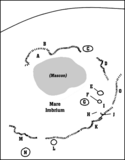Kopernik (krater księżycowy)
 | |
| Ciało niebieskie | Księżyc |
|---|---|
| Średnica krateru | 93 km |
| Głębokość krateru | 3,8 km |
| Wiek | 1,1 Ga |
| Źródło nazwy | Mikołaj Kopernik |

Kopernik (Copernicus) – uderzeniowy krater księżycowy, leżący we wschodniej części Oceanus Procellarum. Krater jest widoczny przez lornetkę, nieco na północny zachód od centrum widocznej z Ziemi półkuli Księżyca.
Jest to jeden z najefektowniejszych kraterów na Księżycu, widoczny w pobliżu środka obserwowanej z Ziemi jego tarczy na północnym brzegu Morza Chmur (Mare Nubium). Wał krateru ma szerokość około 22 kilometrów, wysokość zewnętrzna 1010 metrów, wewnętrzną zaś – 3350 metrów. Średnica dna krateru wynosi około 46 km. Zewnętrzne zbocza wału krateru nachylone są łagodnie. Wybiegają z nich pasma górskie, wśród których widać kraterki, znajdujące się w ogromnych ilościach wokół krateru. Wewnętrzne zbocza wału ukształtowane są tarasowo, przy czym tarasy oddzielone są od siebie wąwozami. Nachylenie zboczy wewnętrznych wynosi od 8,5° do 27°. Na wale krateru znajdują się 23 małe kraterki. Góra centralna krateru ma siedem wyróżniających się wierzchołków, z których najwyższy ma wysokość 730 m. Krater podczas pełni jest tak jasny, że może być zauważony nieuzbrojonym okiem. Jest otoczony długimi, jasnymi smugami[1].
Na południe od krateru leży Mare Insularum, a na południowym zachodzie krater Reinhold. Na północy rozciąga się pasmo gór – Karpat – które stanowią południową krawędź Mare Imbrium. Krater Kopernik powstał ok. 1,1 mld lat temu, rozpoczynając w historii geologicznej Księżyca okres kopernikański.
Nazwę Copernicus nadał kraterowi włoski jezuita Giovanni Battista Riccioli.
Satelickie kratery
| Kopernik | Szerokość | Długość | Średnica |
|---|---|---|---|
| A | 9,5° N | 18,9° W | 3 km |
| B | 7,5° N | 22,4° W | 7 km |
| C | 7,1° N | 15,4° W | 6 km |
| D | 12,2° N | 24,7° W | 5 km |
| E | 6,4° N | 22,7° W | 4 km |
| F | 5,9° N | 22,2° W | 4 km |
| G | 5,9° N | 21,5° W | 4 km |
| H | 6,9° N | 18,3° W | 5 km |
| J | 10,1° N | 23,9° W | 6 km |
| L | 13,5° N | 17,0° W | 4 km |
| N | 6,9° N | 23,3° W | 7 km |
| P | 10,1° N | 16,0° W | 5 km |
| R | 8,1° N | 16,8° W | 3 km |
Zobacz też
Przypisy
- ↑ Andrzej Marks: Księżyc. Warszawa: Państwowe Wydawnictwo Naukowe, 1970.
Linki zewnętrzne
Media użyte na tej stronie
Shiny LightSteelBlue button/marker widget. Used to mark the location of something such as a tourist attraction.
Autor:
- Nuvola_apps_kmoon.png: David Vignoni / derivative work: Lady Whistler (talk)
Icon from Nuvola icon theme for KDE 3.x.
Original description: Southward looking oblique view of Mare Imbrium and Copernicus crater on the Moon. Copernicus crater is seen almost edge-on near the horizon at the center. The crater is 107 km in diameter and is centered at 9.7 N, 20.1 W. In the foreground is Mare Imbrium, peppered with secondary crater chains and elongated craters due to the Copernicus impact. The large crater near the center of the image is the 20 km diameter Pytheas, at 20.5 N, 20.6 W. At the upper edge of the Mare Imbrium are the Montes Carpatus. The distance from the lower edge of the frame to the center of Copernicus is about 400 km. This picture was taken by the metric camera on Apollo 17. (Apollo 17, AS-2444).
Location & Time Information Date/Time (UT): 1972-12 Distance/Range (km): 160. Central Latitude/Longitude (deg): +20.,338. E Orbit(s): N/A
Imaging Information Area or Feature Type: crater, mare, crater chains Instrument: Metric Mapping camera Instrument Resolution (pixels): Film Type - 3400 Instrument Field of View (deg): 76.2 mm Focal Length Filter: None Illumination Incidence Angle (deg): 77. Phase Angle (deg): N/A Instrument Look Direction: N/A Surface Emission Angle (deg): 40.
Ordering Information CD-ROM Volume: N/A NASA Image ID number: AS17-2444 Other Image ID number: N/A NSSDC Data Set ID (Photo): 72-096A-03A NSSDC Data Set ID (CD): N/AOther ID: N/A
cylindrical map projection of the Moon. The Moon's whole surface was mapped by the Clementine spacecraft in 1994, here North is at the top. The dark floor of crater Plato is at the middle top above Mare Imbrium, while the bright floor and rays of crater Tycho is near the middle bottom below Mare Imbrium. Mare Procellarum is at the near left, and Mare Tranquillitatis is just right of centre and Mare Crisium is at the near right. The far left and far right show the contrast of the mostly cratered farside with small isolated mare.
A view of Copernicus crater taken from lunar orbit by Apollo 12. The view is looking north. The keyhole-shaped double crater in the foreground are Fauth and Fauth A.







